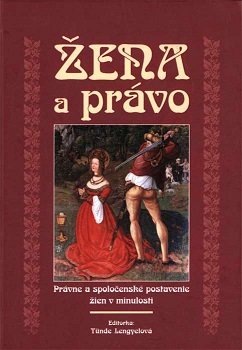Testamenty aristokratických žien v Sedmohradskom kniežatstve
Last Wills of Noble Women in the Transylvanian Principality
Author(s): Ildikó Horn
Subject(s): Gender Studies, History of Law, Civil Law, Modern Age, Culture and social structure , 17th Century
Published by: Historický ústav SAV
Keywords: Transylvanian Principality; women; noble women; will; property; law;
Summary/Abstract: The study is a part of a bigger research project that aims to publish all preserved last wills of princes, aristocracy, middle and lower nobility, burghers and other city-dwellers and churchmen. The contents and the form of last wills depended on the law customs and traditional phrasing and therefore represented a highly formalised genre. In many cases, apart from a testator, there were other people, especially lawyers who influenced the style and wording of the last wills. Therefore, the question arises whether wills could possibly be an indicator of a testator's personality and whether there are any special characteristics of the last wills of women. The author addresses the problem of how many times and at which occasions women would draw their wills, what supplements they added to them and what reasons led them to do so. Testators all around Europe rationalized making their last wills by the same reasons: men are mortal, but no one knows the time of his death and therefore decisions about the division of the property should be made beforehand so the bereaved can peacefully get their share. Nevertheless, most last wills were drawn while in danger of death, during serious illness, plague epidemics or in the war times. It was only in the last third of the 17th century under the influence of baroque piety that the tendency to make a will while still alive and well started to grow. Women would often draw a last will in the time of their pregnancy as many of them died while in labour. Another reason for women was their new marriage as they tried to provide for their children from previous marriages. Amongst burghers and other city dwellers, it was usual for a married couple to make a joint last will in a ceremonious manner. Apart from the questions when and how many times, question how is also interesting. The last wills of prominent men fall into two basic categories. Most of them made a long, detailed, stylistically complex will with the help of lawyers. The second group includes wills made in danger. These are exceptionally short and concise, drawn before awaited war conflict or during acute illness, but most frequently, they are changes of previous last wills. With women, it is not possible to set up similar categories, because the practice of making women's wills was extremely diverse. Unrelated to the amount and value of bequeathed property, women's wills vary enormously in length. The contents of wills, division of property, requests of testators on their bereaved, and experiences and advice they wanted to hand out to them, form the most interesting questions of the analyses. It is surprising that just few wills contain wishes about the burial place, burial ceremony and its expenses. Requests for a final resting-place were usually related to three other aspects - religion, burial expenses and tombstone engravings. The practice of women that had experienced unhappy marriage or married several times is quite interesting. In fact, it was not always a widow's last husband who she wished to be buried next to. Wills often contain a short resume, an evaluation of marriage, but there are substantial differences between men and women . Men were usually more critical and openly spoke about problems. Women were more reserved in the assessment of their marriage. Typically, they were critical only of the fact that their husbands spent their money and did not provide for their living. However, it is a telltale sign if a woman did not wish to be buried next to her husband, used her maiden name or did not mention her husband in her will at all. Analyses of the relation to one's children revealed that mothers forgave much more easily. There are numerous examples of cases, when a father disinherited a child from acquired estates, whereas there is only one case when a mother did so. Women had more positive attitude also towards their other relatives. Distributive parts of last wills are valuable not only for disclosing quality of relationships in a family, but also for often being the only complete evidence about a woman's property. Women from rich aristocratic circles showed a leaning for charity. Hospitals, poorhouses were under their patronage and they took care of the disabled, the poor, orphans and deprived widows. Another thing is, however, how wills were executed in practice. To a considerable extent, last wills fulfilment depended on the relation of a testator to his or her relatives and on conscientiousness of wills executors. Testators were aware of such difficulties and tried all the possibilities provided in the law to secure their last wills. Moreover, it was a usual custom - and according to our findings, it seems that it was used much more by women than men - to add blessing and cursing formulas against those who would and those who would not comply with their wills. It seems as if women believed more in blessing and cursing than secular justice.
Book: Žena a právo. Právne a spoločenské postavenie žien v minulosti
- Page Range: 126-141
- Page Count: 16
- Publication Year: 2004
- Language: Slovak
- Content File-PDF

